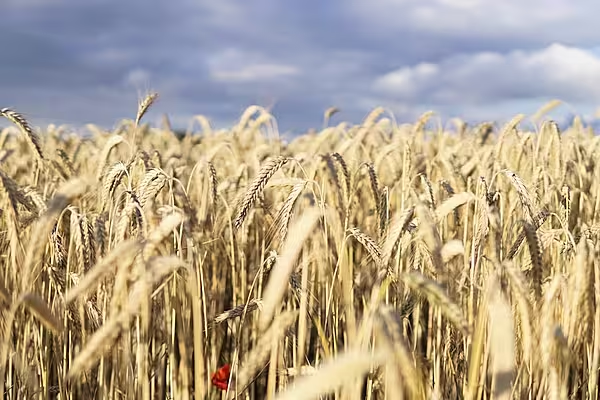Russia, the world’s biggest wheat exporter, is about to grab even more customers in the fast-growing economies of Asia -- a region that normally gets most of its imported grain from somewhere else.
A farm industry that emerged from the former Soviet Union to become a wheat-trade powerhouse is poised to expand its market share in countries like China, Indonesia and Japan. That’s because droughts are eroding production in Australia, the U.S. and Canada. Those are the dominant suppliers of wheat to Asia, which accounts for about a third of global imports.
While shipments of wheat from Russia already were expected to exceed those of any other country, very little usually ends up in Asia, where imports have almost doubled in a decade as rising incomes boosted demand for noodles, cakes and breads. But this season, Australian production will plunge the most in a decade, American farmers will have their smallest harvest since 2002, and Canada’s crop will shrink for the third time in four years.
Big Winner
“Russia will be a big winner,” said Benjamin Bodart, a director at adviser CRM Agri-Commodities in Newmarket, England. “Russia’s crop is expected to be a record. They will need to find markets to supply that wheat to.”
For a second straight season, growers from the Black Sea to southern Siberia are collecting Russia’s largest wheat crop ever. The U.S. Department of Agriculture estimates production will rise to 77.5 million metric tons, exceeding domestic consumption by the widest margin on record.
The U.S. had been the world’s top exporter for decades, but was supplanted by Russia in 2015-16 before regaining the title last season. The USDA forecasts Russia will be back on top in the 12-month marketing season that began July 1, with exports jumping 13 percent from a year earlier to 31.5 million tons, almost three times what they were in 2012-13.
Russian wheat hasn’t been much of a player in Asia, partly because it’s such a long journey for grain cargoes. Exports must travel from the Black Sea into the Mediterranean, then through the Suez Canal and around India to reach countries like Indonesia, which has almost doubled imports in the past decade to become the world’s largest buyer after Egypt. Demand growth has been rapid in Southeast Asia, which vies with the Middle East and North Africa as the largest buying region, USDA data show.
To be sure, Russian shipments to south, east and Southeast Asia surged 60 percent in 2016-17 to 3 million tons, according to UkrAgroConsult. But that still only accounted for about 5 percent of the region’s total imports. By comparison, the U.S., Australia and Canada supplied almost all of Japan’s imports in recent years and about three quarters of Indonesia’s 10 million tons of foreign purchases last season, according to the USDA. China gets about a third of its imports from the U.S.
More Shipments
With a much larger surplus expected from Russia this year and less available from Asia’s traditional suppliers, the Institute for Agricultural Market Studies, known as IKAR, said Russia may send more to Indonesia, Vietnam and the Philippines this season. Sergey Feofilov, the general director of UkrAgroConsult in Kiev, says demand also may increase from Japan, Malaysia and China.
At the same time, total U.S. exports will shrink 7.6 percent this season, while Canada will divert more to its southern neighbor, where a poor crop of high-protein spring wheat has boosted demand for imports, government data show.
“The limited availability of Canadian and U.S. wheat is expected to have a major impact on the global market,” the USDA said in a report this month.
Compounding the problem will be Australia, which is the top supplier to Asia. The Southern Hemisphere’s largest grower will see its exports slump by a fifth, according to the USDA. Rabobank International warned the nation’s 2017-18 harvest may be further hurt if dry and warm weather persists.
Shipments
Russia has already started stepping up shipments. Exports to Indonesia exceeded 330,000 tons in the first quarter, up from just 991 tons for all of 2016, after a quarantine issue was resolved, according to Franciscus Welirang, chairman of the Indonesian Flour Mills Association.
“Black Sea is such a powerhouse nowadays, so ignore Black Sea fundamentals at your peril,” said Tom Basnett, general manager at Market Check, a Sydney-based commodity consultant. Australian traders watch Black Sea market conditions for indications on how to price grain “to compete with Russia into our typical export destinations,” he said.
Still, the quality of Russian wheat may not be high enough to tempt some Asian buyers away from North American supplies. While ample rains boosted Russian yields, they probably cut protein levels for some of the crop, said Dmitry Rylko, IKAR’s director general.
American supplies remain competitive on global markets, which may discourage switching, CRM’s Bodart said. With mounting concern that bulging world inventories will prolong a surplus, futures on the Chicago Board of Trade have plunged 23 percent since early July to $4.31 a bushel. U.S. wheat has only been cheaper at this time of year once before in the past decade, and that was during a record global harvest.
Beyond this season, there’s little indication that demand will slow in Southeast Asia. The region’s usage is expected to jump by about a third in the five years through 2020, Rabobank estimates. That will prompt countries there to turn more toward grain from Black Sea nations, particularly for animal feed, the bank said. Russia’s neighbors Ukraine and Kazakhstan are also big exporters.
Russia may also gain more of a foothold in Asia because flour makers there have become better at blending various types of grain for milling purposes, according to Basnett at consultant Market Check.
“Milling technology is probably the main handbrake” that’s curbed demand for Russian grain, Basnett said. “However, this is ever improving, and therefore Asian millers will be able to incorporate a higher percentage of the lower quality and materially cheaper Russian wheat.”
News by Bloomberg, edited by ESM. Click subscribe to sign up to ESM: The European Supermarket Magazine.














